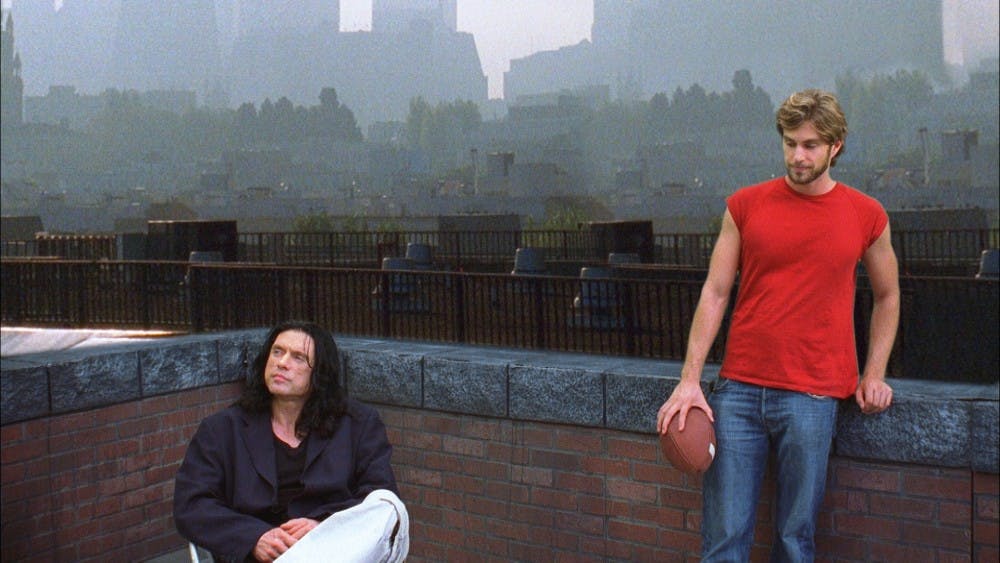While Tommy Wiseau’s new movie “Best F(r)iends” is set to release March 30, it is his first film, “The Room,” that has become a classic, not for its artistic brilliance but for its intoxicating awfulness.
Dubbed the worst movie ever made, “The Room” is the “Citizen Kane” of bad movies, with its continuity slips, subplots that rail into instant dead-ends, and ridiculous non-sequiturs.
While the film cost $6 million, it grossed only $1,800 and closed after two weeks. But now, it plays at sold-out midnight screenings across the continent.
It has spawned a Golden Globe-nominated behind-the-scenes movie, a computer game, a stage adaptation, parodies, memes, and branded T-shirts and underwear. It has popularized classic quotes, including the famous “You’re tearing me apart, Lisa!” and “It’s bullshit. I did not hit her. I did noooot. Oh hi, Mark!”
The film has garnered a cult following with its own rituals, including throwing plastic spoons at the screen during showings. But it is still, at its core, bad.
We’re supposed to hate bad art and appreciate great art, but some art is so bad that it’s good. While “The Room” is the grandmaster of movies so bad they’re good, it is far from the first of its kind.
“Plan 9 From Outer Space” and “The Rocky Horror Picture Show” are classic film examples, but the phenomenon extends past the film sphere to art in general.
The Museum of Bad Art in Somerville, Massachusetts specializes in so-bad-it’s-good artwork they call “art too bad to be ignored.”
But what makes art so bad it’s good, and why is some art just plain bad?
It is often what makes the art so bad — the nonsensical plots of films, the distorted faces of portraits, the screeching cacophony of untrained voices — that draws people in. But what differentiates the good bad from the just plain bad is the intention behind the art.
Wiseau threw $6 million into “The Room” and is a genuine movie fan who thought he was creating a masterpiece. “The Room” was his passion project. The film was different from most bad art because it was a shot at brilliance, not mediocrity, that failed. It had heart, and we loved it unironically.
The MoBA also requires its art to come from genuine attempts because its creators also realized that bad art is no fun when someone is trying to fail. What is fun is a beautifully terrible freak of nature born from something ernest.
So, by loving good bad art, are we just finding our joy in the failure of others? Should I be questioning my morals because of my love of “The Room?” It’s really not very nice to laugh at the failures of others.
While laughing at the failure of others may be part of it, by that logic, any bad art that failed would file in among the ranks of good bad art.
Good bad art must fail spectacularly, in a bewildering fashion, in a way that makes you think, “How could anyone have thought this would be good?”
Good bad art is also bizarrely disconnected. “The Room” is set in the real world, but the characters don’t behave in a way that is logical to us. It grabs our schema of the world and destroys it with inorganic mood swings, disconnects between emotion and dialogue and illogical plot choices.
“The Room” is dislocating — one gigantic black hole of a plot hole. The film, just like a poorly-drawn landscape or a hellishly-played tune, pulls the rug of orderliness and logic from under our feet and leaves us laughing at how disoriented we are.
The last thing that is like icing on the cake of a good bad piece of art is the person behind it.
A lot of what attracts people to “The Room” is Wiseau, who claims he’s “forty-something” when he clearly is not, says he’s from New Orleans despite his Eastern European-esque accent, and is loaded but claims he got the cash for his film from real estate. It is just as much the mystery behind the eccentric good bad artist as it is the movie itself that draws viewers in.
The famously terrible soprano singer Florence Foster Jenkins had the same genuine love for her craft Wiseau has. She was also almost as interesting of a person as he is.
She was known for her flamboyant costumes that often included angel wings. She was strict about audience attendance and usually only played at small clubs.
She also gifted a taxi driver that got her into a car crash with expensive cigars after he caused her to scream the highest note to ever come out of her mouth — an F above high C.
Jenkins was also exquisitely bad. But she gained a cult following and sold out Carnegie Hall.
Jenkins, Wiseau and countless other good bad artists are genuine yet bewilderingly bad — the two main ingredients in the recipe for art that is so bad that it’s good. While the just plain bad fades into the shadows of the art world, good bad art builds cult followings and leaves legacies that often stretch beyond what even good art can claim.




